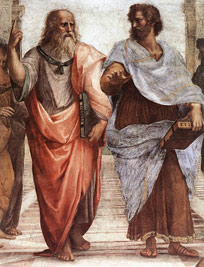
Greece
Aristotle (384–322 BCE)
In terms of his philosophical influence, only Plato is his peer. Aristotle’s works shaped centuries of philosophy from Late Antiquity through the Renaissance. A prodigious researcher and writer, Aristotle left a great body of work, perhaps numbering as many as two-hundred treatises, from which approximately thirty-one survive.

Plato’s student Aristotle studied at the Academy for nearly twenty years, leaving after Plato’s death, in 347 BCE. Three years later he was invited by Philip II of Macedon to become the tutor to his son Alexander the Great, which he did for at least another three years before traveling to Asia Minor where he went with Theophrastus to Lesbos to research the botany and zoology of the island. He finally returned to Athens where he established his own school, known as the Lyceum and taught there for twelve years.
As a well-known quote has it: “To Plato all chairs are just inferior forms of the perfect chair. To Aristotle if you add up all the different types of chair and reduce them to their common denominator, then you would understand what a chair is.”
Plato’s philosophy of Forms would have been familiar to Aristotle’s students, but like the pre-Socratic philosophers before him – those he called the “Investigators of Nature” – Aristotle encouraged his students to look at what was in front of them, to seek the nature of those forms and the primary instances of them as they exist right here in the world. Aristotle believed that the search for wisdom should begin with the sense perceptions and that through these we can acquire the understanding of both facts and causes, and the universal principles and primary causes on which they are built. His approach was strictly empirical, through observation, classification and deductive reasoning we would come to understand the causes and characteristics of things.
Aristotle became extremely critical of the notion that the ideal world was more real than the material universe, and questioned the independent objective existence of Forms. To him qualities of beauty, courage, roundness, etc. existed only in the material objects themselves.
“…the Forms …are not the causes of motion or of any other change …And they do not in any way help either towards the knowledge of the other things …or towards their existence …Moreover, all other things do not come to be from the Forms in any of the usual senses of “from.” And to say that the Forms are patterns and that the other things participate in them is to use empty words and poetic metaphors.” says Joe Sachs, St. John’s College, Annapolis.
He describes the Unmoved Mover as being non-matter, perfectly beautiful, indivisible, and contemplating only the perfect contemplation of itself contemplating.
Aristotle and his students collected data on any and all aspects of the physical world and proceeded deductively to form theories and conclusions from the largest amount of data possible. He not only studied almost every subject possible at the time, but made significant contributions to most of them. In physical science, Aristotle studied anatomy, astronomy, economics, embryology, geography, geology, meteorology, physics and zoology. In philosophy, he wrote on aesthetics, ethics, government, metaphysics, politics, psychology, rhetoric and theology. He also studied education, foreign customs, literature and poetry.
Aristotle’s work in metaphysics was motivated by a desire for wisdom, which requires the pursuit of knowledge for its own sake. Through observation and logical reasoning Aristotle arrived at the concept of the Unmoved Mover: one can observe that there is motion in the world, that things that move are set in motion by something else, there can be a chain of motion, but there must be something that caused the very first motion. This first cause set the universe into motion, it is not moved by any prior action but by desire. He describes the Unmoved Mover as being non-matter, perfectly beautiful, indivisible, and contemplating only the perfect contemplation of itself contemplating. Modern physics has proven his premise to be wrong, but to Aristotle this was a rational idea arrived at through deduction and logic.
Karen Armstrong says in The Great Transformation, “Aristotle was a pioneer of great genius. Almost single-handedly he had laid the foundations of Western science, logic, and philosophy. Unfortunately, he also made an indelible impression on Western Christianity. Ever since Europeans discovered his writings in the twelfth century C.E., many became enamored of his rational proofs for the Unmoved Mover – actually one of his less inspired achievements. Aristotle’s God, which was not meant to be a religious value, was foreign to the main thrust of the Axial Age, which had insisted that the ultimate reality was ineffable, indescribable, and incomprehensible – and yet something that human beings could experience, though not by reason. But Aristotle had set the West on its scientific course ….”
